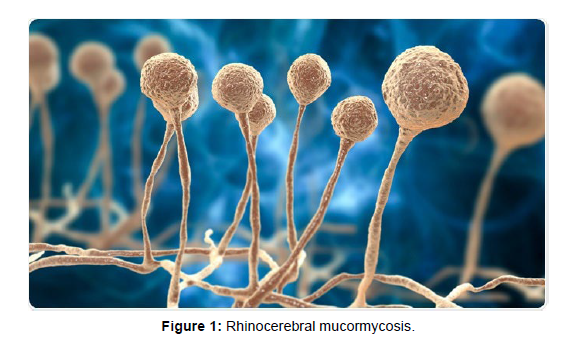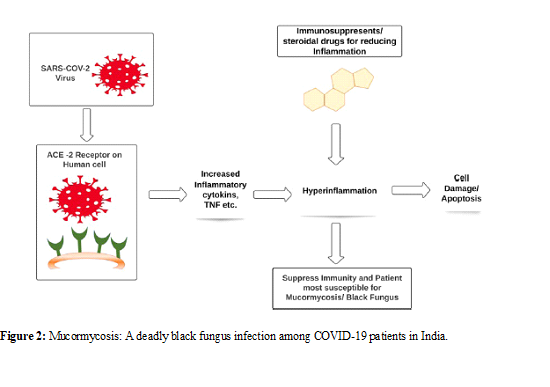The Rise of Mucormycosis: Understanding the Causes and Impacts of this Deadly Fungal Infection
Received: 03-May-2023 / Manuscript No. JCPHN-23-98095 / Editor assigned: 05-May-2023 / PreQC No. JCPHN-23-98095 (PQ) / Reviewed: 19-May-2023 / QC No. JCPHN-23-98095 / Revised: 22-May-2023 / Manuscript No. JCPHN-23-98095 (R) / Published Date: 29-May-2023 DOI: 10.4172/2471-9846.1000413
Abstract
Mucormycosis is a rare but deadly fungal infection that has recently emerged as a significant health concern in several parts of the world, including India, which is currently facing a major outbreak. The infection, also known as zygomycosis, is caused by a group of fungi called mucormycetes, which are commonly found in soil, decaying organic matter, and other environmental sources. While the fungi are widespread, infections are rare and typically occur in people with weakened immune systems or underlying medical conditions. However, the recent outbreak in India has raised concerns about the spread of the infection and the need for effective prevention and treatment strategies.
Keywords
Mucormycosis; Fungal infection; Zygomycosis
Introduction
Mucormycosis is caused by exposure to mucormycetes fungi, which can enter the body through inhalation, ingestion, or open wounds. Once inside the body, the fungi can grow and spread rapidly, causing tissue damage and other serious health complications. The risk of infection is higher in people with weakened immune systems, such as those with HIV/AIDS, cancer, or organ transplants. Other factors that can increase the risk of infection include uncontrolled diabetes, prolonged use of steroids or other immunosuppressive medications, and certain medical procedures such as chemotherapy or organ transplantation [1, 2].
Methodology
Symptoms and impacts of Mucormycosis
The symptoms of mucormycosis vary depending on the location of the infection, but common signs include fever, headache, facial pain, swelling, and black lesions on the skin. In severe cases, the infection can spread to the lungs, brain, or other vital organs, leading to organ failure and death. The impact of mucormycosis on patients and their families can be devastating, as the infection is difficult to treat and can cause long-term disability and disfigurement [3, 4].
Prevention and treatment of Mucormycosis
Preventing mucormycosis requires a multi-pronged approach that includes reducing exposure to mucormycetes fungi, controlling underlying medical conditions, and improving infection control measures in healthcare settings. For example, people with uncontrolled diabetes should work with their healthcare providers to manage their blood sugar levels, while those undergoing chemotherapy or other medical procedures should be closely monitored for signs of infection. In healthcare settings, proper sterilization of medical equipment and surfaces can also help reduce the risk of infection (Figure 1).
Treatment of mucormycosis typically involves a combination of antifungal medications and surgical removal of infected tissue. However, the success of treatment depends on early detection and intervention, as the infection can rapidly spread and cause serious health complications. In severe cases, amputation or other radical surgical interventions may be necessary to control the infection and prevent further damage to the body [5,6].
Factors Contributing to the rise of Mucormycosis cases in India
COVID-19: One of the primary factors contributing to the rise of mucormycosis cases in India is the COVID-19 pandemic. COVID-19 weakens the immune system, making individuals more susceptible to opportunistic infections like mucormycosis. Additionally, the use of steroids to treat COVID-19 can further suppress the immune system, increasing the risk of fungal infections like Mucormycosis (Table 1).
| S. No. | Fungus type | Visible patched | Curable | Pre-medical condition | Affected areas | |
|---|---|---|---|---|---|---|
| 1 | Black | Yes- black in colour | Yes | Diabetes | eyes, brain, lungs, sinuses | |
| 2 | White | Yes- white in colour | Yes | Diabetes | body, skin, tongue, brain, etc. | |
| 3 | Yellow | No | Yes -if diagnosed early else fatal | Diabetes | Internal body organs | |
| 4 | Green | No | Yes- easy to cure | Diabetes | lungs | |
Table 1: Types of Fungal Infections
Poor Hygiene: Another factor contributing to the rise of mucormycosis cases in India is poor hygiene practices. Mucormycosis is a fungal infection that typically affects individuals with weakened immune systems, but it can also occur in individuals who have been exposed to fungal spores in the environment. Poor hygiene practices can increase the risk of exposure to fungal spores, making individuals more susceptible to mucormycosis.
Overuse of Antibiotics: Overuse of antibiotics is another factor contributing to the rise of mucormycosis cases in India. Antibiotics can disrupt the natural balance of microorganisms in the body, allowing fungal infections like mucormycosis to take hold. Overuse of antibiotics can also weaken the immune system, increasing the risk of fungal infections [7, 8].
Implications of the rise of Mucormycosis cases in India
Increased Healthcare Burden: The rise of mucormycosis cases in India has placed a significant burden on the healthcare system. Treatment for mucormycosis requires specialized medical care, including antifungal medication and, in some cases, surgery. As the number of cases continues to rise, the healthcare system may struggle to provide adequate care to all those in need (Figure 2).
Financial Burden: Treatment for mucormycosis can be expensive, placing a significant financial burden on patients and their families. Many individuals in India may not have the financial resources to pay for the necessary treatment, which could lead to untreated cases and poorer health outcomes [9, 10].
Conclusion
Mucormycosis is a rare but deadly fungal infection that has recently emerged as a significant health concern in several parts of the world, including India. While the fungi that cause the infection are widespread, infections are rare and typically occur in people with weakened immune systems or underlying medical conditions. However, the recent outbreak in India has raised concerns about the spread strategies. To prevent the spread of mucormycosis, it is important to reduce exposure to mucormycetes fungi, control underlying medical conditions, and improve infection control measures in healthcare settings. Effective treatment of mucormycosis requires early detection and intervention, as the infection can rapidly spread and cause serious health complications. With increased awareness and effective prevention and treatment strategies, we can reduce the impact of mucormycosis on patients and their families and improve the overall health and well-being of our communities [11, 12].
References
- Munro AK, Hunter EC, Hossain SZ, Keep M (2021) A systematic review of the menstrual experiences of university students and the impacts on their education: A global perspective. PloS One 10: 16.
- Patil R, Agarwal L, Khan MI, Gupta SK, Vedapriya DR, et al. (2021) Beliefs about menstruation: a study from rural Pondicherry. Indian Journal of Medical Specialties 2: 23-26.
- Chawla J Matrika (1992) The mythic origins of the menstrual taboo in the Rig Veda.
- Puri S, Kapoor S (2006) Taboos and myths associated with women’s health among rural and urban adolescent girls in Punjab. Indian journal of community medicine 31: 295.
- Kumar A, Srivastava K (2011) Cultural and social practices regarding menstruation among adolescent girls. Social work in public health 26: 594- 604.
- Penakalapati G (2013) " Boys don't have knowledge about menstruation; they think it is a bad thing"-Knowledge and Beliefs about Menstruation among Adolescent Boys in Gicumbi District, Rwanda.
- Mason L, Sivakami M, Thakur H, Kakade N (2017) ‘We do not know’: a qualitative study exploring boys perceptions of menstruation in India. Reproductive Health 14: 1- 9.
- Gundi M, Subramanyam MA (2020) Curious eyes and awkward smiles: Menstruation and adolescent boys in India. Journal of Adolescence 85: 80-95.
- Finlay JE, Assefa N, Mwanyika‐Sando M, Dessie Y, Harling G, et al. (2020) Sexual and reproductive health knowledge among adolescents in eight sites across sub‐Saharan Africa. Tropical Medicine & International Health 25: 44-53.
- Rani A, Sharma MK, Singh A (2016) Practices and perceptions of adolescent girls regarding the impact of dysmenorrhea on their routine life: a comparative study in the urban, rural, and slum areas of Chandigarh. International journal of adolescent medicine and health 28: 3-9.
- Wong LP (2011) Premenstrual syndrome and dysmenorrhea: urban-rural and multiethnic differences in perception, impacts, and treatment seeking. Journal of pediatric and adolescent gynecology 24: 272-277.
- Mohammed S, Larsen-Reindorf RE (2020) Menstrual knowledge, sociocultural restrictions, and barriers to menstrual hygiene management in Ghana: Evidence from a multi-method survey among adolescent schoolgirls and schoolboys. Plos One 15.
Indexed at, Google Scholar, Cross Ref
Indexed at, Google Scholar, Crossref
Indexed at, Google Scholar, Crossref
Indexed at, Google Scholar, Crossref
Indexed at, Google Scholar, Crossref
Indexed at, Google Scholar, Crossref
Citation: James D (2023) The Rise of Mucormycosis: Understanding the Causesand Impacts of this Deadly Fungal Infection. J Comm Pub Health Nursing, 9: 413. DOI: 10.4172/2471-9846.1000413
Copyright: © 2023 James D. This is an open-access article distributed under theterms of the Creative Commons Attribution License, which permits unrestricteduse, distribution, and reproduction in any medium, provided the original author andsource are credited.
Share This Article
Recommended Journals
Open Access Journals
Article Tools
Article Usage
- Total views: 1019
- [From(publication date): 0-2023 - Dec 19, 2024]
- Breakdown by view type
- HTML page views: 936
- PDF downloads: 83


